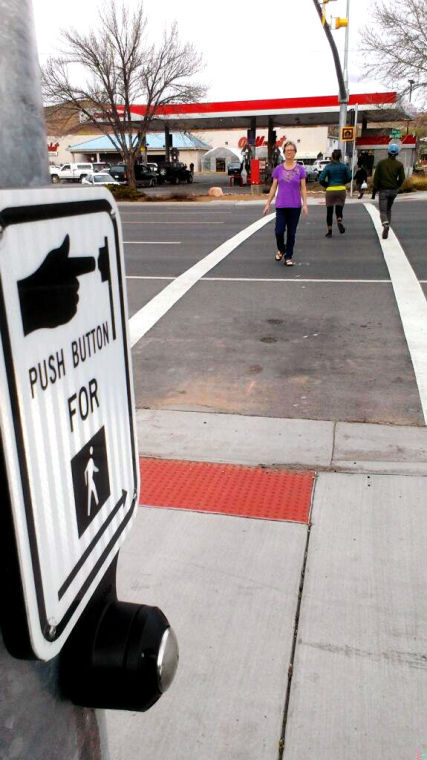The Utah Department of Transportation (UDOT) finished installing two new pedestrian crossing lights on Main Street on March 28. The lights were installed at Uranium Avenue and 200 South.
“The intended purpose of the flashing lights is to help enhance the safety of pedestrians crossing at those locations,” UDOT communications manager Kevin Kitchen said.
As Moab heads into its tourist season, local roads and intersections become busy. City Engineer Rebecca Andrus said many times people will not wait for appropriate gaps in traffic when crossing at busy intersections.
“When a person is waiting to cross the road, and it is getting longer and longer, their ‘gap acceptance tolerance’ goes down,”she said. “They will run across and try to make it maybe to the center of road, and then shoot the rest of the way. It can be very dangerous.”
Concerned with the safety of several intersections along Moab’s Main Street, the City of Moab made a request to UDOT to conduct a study to determine if they warranted some type of signal.
“There have been issues at these intersections, both with vehicles and pedestrians, and we’ve had a lot of concerns because of this,” Andrus said.
UDOT conducted the study, which included looking at the intersections of Main Street with 400 North, 200 North, 200 South, Uranium Avenue, and Dogwood Avenue, in May 2013. For the study, UDOT performs a pedestrian traffic count at the locations to determine the volume of pedestrian traffic.
Kitchen said after the pedestrian traffic count is concluded, an engineer reviews the findings.
“The consideration to provide, or not provide, marked crosswalks and/or other pedestrian facility enhancements are then based on engineering judgment and the recommended criteria listed in Policy 06C-27,” he said.
UDOT Policy 06C-27 states “[Marked] crosswalks should not be installed at locations that could present an increased safety risk to pedestrians…without first providing adequate design features and/or traffic control devices.”
Based on the results of the study, pedestrian traffic signals were installed at 200 South and Uranium Avenue .
“These two intersections warranted pedestrian signals,” Andrus said. “They did not warrant a full traffic signal.”
Andrus explained the study was conducted on a Wednesday in May of 2013. The City has put in another request for UDOT to return to the intersections and conduct another study on a Friday or Saturday in May or June of this year.
“We explained that Moab does not necessarily run on the same time schedule that most cities do,” Andrus said. “We don’t have the nine-to-five workday with a morning rush and then an evening rush. The whole dynamic of how traffic works here is completely different than other places.”
Moab Mayor Dave Sakrison explained that the City of Moab has been requesting a traffic light be installed at the 200 South intersection for almost five years.
“We have been trying to get a traffic light on 200 South forever,” he said. “Studies have never warranted an official traffic light there because it would impede the flow of traffic through town to add another light there.”
UDOT has agreed to return on a weekend later this spring, but an exact date for the study has not been set. Andrus said the signals were installed to be adaptable for transitioning into a full traffic light, if necessary.
Crossing lights similar to the one installed in Moab have been used in cities around Utah, Kitchen said.
“UDOT has also installed these types of crossings in downtown Cedar City and in Kaysville,” Kitchen said. “They have been found to be effective in those locations.”
Whether the lights will be as effective in Moab remains to be seen. Sakrison said the city does not have any type of plan in place to track the effectiveness of the lights. Kitchen said UDOT looks for reductions in vehicle and pedestrian collisions as a way of tracking.
The crossing lights, which have yellow lights that blink, are activated when a pedestrian presses a button located by the entrance to the crosswalk. Once activated, the lights blink both on the sides and above the crosswalk. The pedestrian has 24 seconds to cross the street at this point.
Andrus said pedestrians still need to use caution when entering the crosswalks.
“The yellow lights are not forcing anyone to stop,” she said. “(The lights) should let the cars know there is someone crossing the road and to stop at the crosswalk, but pedestrians should still use caution.”
UDOT said once the person has cleared the crosswalk, regardless of the if the lights are still blinking, cars are legal to proceed through the intersection. Pedestrians should also be aware that the lights for crossing start as soon as the button is pushed, there is no delay or warning time, which means not all vehicles will stop immediately.
“It looks like it will take people a while to get used to this,” Sakrison said. “Pedestrians and vehicular traffic isn’t quite sure what to think of the lights just yet. It is still just a little confusing.”
UDOT study concluded 200 South and Uranium Ave. needed devices
“We explained that Moab does not necessarily run on the same time schedule that most cities do. We don’t have the nine-to-five workday with a morning rush and then an evening rush. The whole dynamic of how traffic works here is completely different than other places.”




